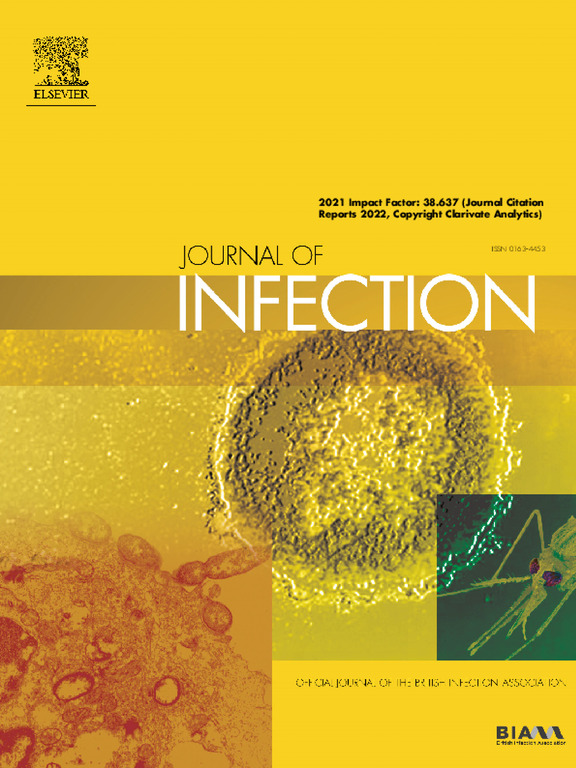Comparison of short- and long-term humoral immune responses to pneumococcal polysaccharide and glycoconjugate vaccines in an HIV-infected population
IF 14.3
1区 医学
Q1 INFECTIOUS DISEASES
引用次数: 0
Abstract
Background
Immunisation is recommended internationally to protect against pneumococcal infections in HIV-infected adults. However, vaccination schedule designs are mostly based on studies of initial rather than long-term antibody responses. This UK observational study investigated the short- and long-term antibody responses to polysaccharide and glycoconjugate pneumococcal vaccines in an adult HIV-infected cohort.
Methods
We studied a subgroup of 152 of 839 participants from the AIR (Assessment of Immune Responses to Routine Immunisations in HIV-infected Adults, ISRCTN95588307) study that had received pneumococcal vaccinations and had blood samples collected pre- and post-vaccination, as well as at least annually for four subsequent calendar years. Patients received either Pneumovax-23 (PPV, N = 89) or Prevenar-13 (PCV, N = 63) as their primary vaccine, with immunity assessed by measuring IgG antibody concentrations for 12 pneumococcal polysaccharide serotypes (PnPS). The primary outcome was achieving IgG antibody concentrations above the recommended World Health Organisation (WHO) threshold of 0.35 µg/mL for at least 8/12 of the PnPS assessed (WHO≥8/12PnPS). Patients who did not achieve WHO≥8/12PnPS after the primary vaccination were offered further vaccination with PCV; booster vaccinations with PCV were additionally offered to those where antibody levels subsequently fell below the WHO≥8/12PnPS threshold.
Results
Patients receiving PCV as their primary pneumococcal vaccine were significantly more likely to achieve WHO≥8/12PnPS after a single vaccine dose than those receiving PPV (54% vs. 33%, p = 0.012). This difference persisted following booster vaccination with PCV, with cumulative rates of WHO≥8/12PnPS in those receiving PCV vs. PPV as the primary vaccine of 88% vs. 67% and 100% vs. 85% after receiving up to one and two booster vaccinations, respectively. Where WHO≥8/12PnPS was achieved, this persisted significantly longer in those receiving PCV as their primary vaccine compared to PPV (median: 23.5 vs. 11.1 months; p = 0.010).
Conclusions
Immunisation with PCV resulted in quantitatively greater antibody responses than immunisation with PPV in a cohort of HIV-infected UK adults. Individuals receiving PCV as their primary vaccine required fewer total pneumococcal vaccine doses to achieve WHO≥8/12PnPS and experienced greater duration of time above this threshold than those with PPV as the primary vaccine. However, the median longevity of both vaccine responses was relatively short, which supports the use of ongoing booster doses using high-valency glycoconjugate vaccines to sustain WHO≥8/12PnPS threshold antibody levels.
比较艾滋病毒感染人群对肺炎球菌多糖疫苗和糖结合疫苗的短期和长期体液免疫反应。
背景:国际上建议对感染艾滋病毒的成年人进行免疫接种,以预防肺炎球菌感染。然而,疫苗接种计划的设计大多基于初期抗体反应而非长期抗体反应的研究。英国的这项观察性研究调查了感染艾滋病毒的成人队列中对多糖和糖结合肺炎球菌疫苗的短期和长期抗体反应:我们对 AIR(艾滋病病毒感染成人常规免疫接种免疫应答评估,ISRCTN95588307)研究的 839 名参与者中的 152 人进行了亚组研究,这些参与者接受过肺炎球菌疫苗接种,并在接种前和接种后采集了血样,在随后的四个日历年中至少每年采集一次血样。患者接种的主要疫苗是 Pneumovax-23(PPV,人数=89)或 Prevenar-13(PCV,人数=63),免疫力通过测量 12 种肺炎球菌多糖血清型 (PnPS) 的 IgG 抗体浓度进行评估。主要结果是至少8/12个被评估的肺炎球菌血清型(WHO≥8/12PnPS)的IgG抗体浓度超过世界卫生组织(WHO)推荐的阈值0.35µg/ml(WHO≥8/12PnPS)。对初次接种后未达到WHO≥8/12PnPS的患者进一步接种PCV;对抗体水平随后低于WHO≥8/12PnPS阈值的患者进一步接种PCV:结果:接种 PCV 作为主要肺炎球菌疫苗的患者在单次接种后达到 WHO≥8/12PnPS 的可能性明显高于接种 PPV 的患者(54% 对 33%,P=0.012)。这种差异在接种 PCV 强化疫苗后依然存在,接种 PCV 与 PPV 作为主要疫苗的接种者在接种最多一次和两次强化疫苗后,WHO≥8/12PnPS 的累积接种率分别为 88% 对 67% 和 100% 对 85%。在达到 WHO≥8/12PnPS 的情况下,接种 PCV 作为主要疫苗的人群比接种 PPV 的人群的持续时间要长很多(中位数:23.5 个月对 11.1 个月;P=0.010):结论:在一组感染艾滋病毒的英国成年人中,接种 PCV 比接种 PPV 产生的抗体反应更强。与接种 PPV 作为主要疫苗的人相比,接种 PCV 作为主要疫苗的人要达到 WHO≥8/12PnPS 所需的肺炎球菌疫苗总剂量更少,超过这一临界值的持续时间更长。然而,两种疫苗应答的中位持续时间都相对较短,这支持使用高价糖结合疫苗持续加强剂量来维持 WHO≥8/12PnPS 临界抗体水平。
本文章由计算机程序翻译,如有差异,请以英文原文为准。
求助全文
约1分钟内获得全文
求助全文
来源期刊

Journal of Infection
医学-传染病学
CiteScore
45.90
自引率
3.20%
发文量
475
审稿时长
16 days
期刊介绍:
The Journal of Infection publishes original papers on all aspects of infection - clinical, microbiological and epidemiological. The Journal seeks to bring together knowledge from all specialties involved in infection research and clinical practice, and present the best work in the ever-changing field of infection.
Each issue brings you Editorials that describe current or controversial topics of interest, high quality Reviews to keep you in touch with the latest developments in specific fields of interest, an Epidemiology section reporting studies in the hospital and the general community, and a lively correspondence section.
 求助内容:
求助内容: 应助结果提醒方式:
应助结果提醒方式:


